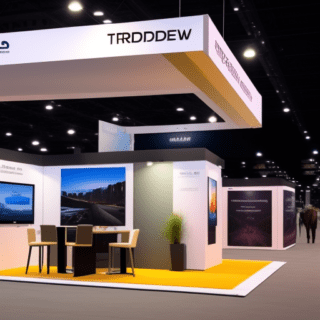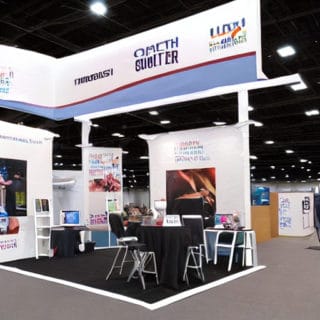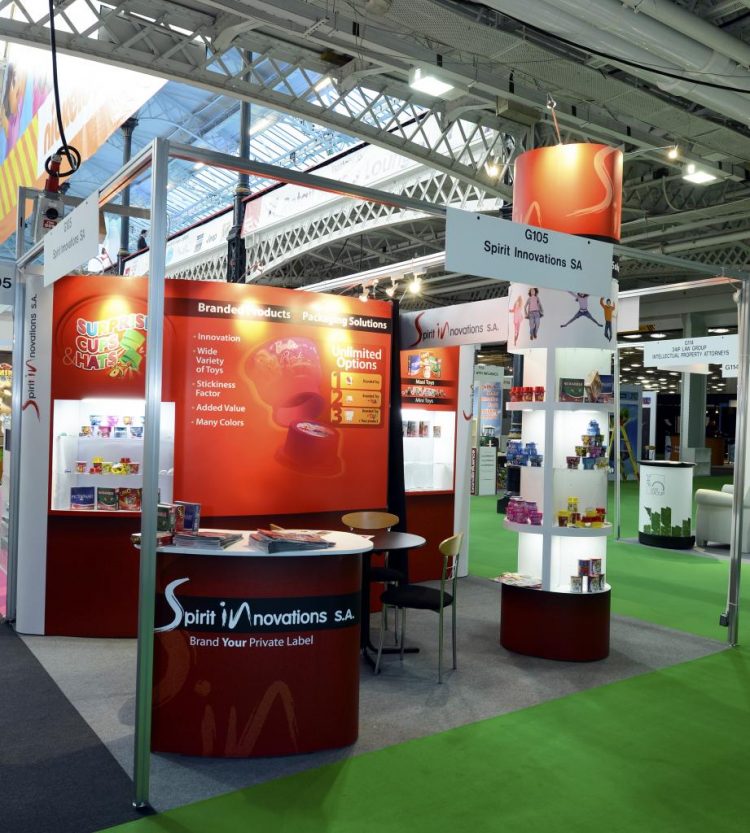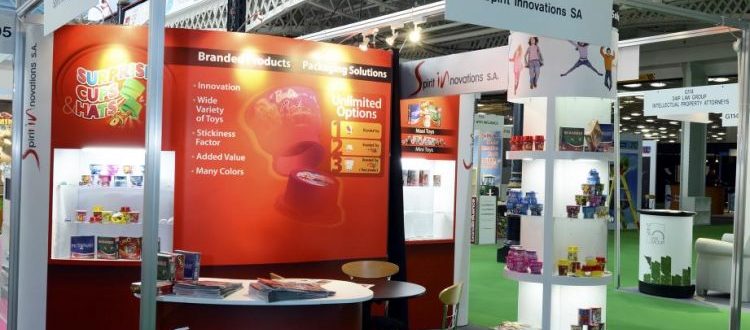Tradeshows are a great way for businesses to showcase their products and services to a large audience. But with so many companies vying for attention, how do you make sure your booth stands out? This is where having a well-designed and strategically planned tradeshow booth comes into play.
A great booth can attract potential customers, generate leads, and leave a lasting impression on attendees. In this article, we will explore the importance of a well-designed tradeshow booth and provide tips on how to create a booth that will make your business shine at your next event.
What is a Tradeshow Booth?
 A tradeshow booth is a designated area within a tradeshow or exhibition where businesses can showcase their products, services, or brand. Typically, a booth consists of a branded display, signage, and promotional materials to attract attendees and potential customers. Booths can vary in size and design, with displays ranging from simple tabletop displays to large custom-built structures.
A tradeshow booth is a designated area within a tradeshow or exhibition where businesses can showcase their products, services, or brand. Typically, a booth consists of a branded display, signage, and promotional materials to attract attendees and potential customers. Booths can vary in size and design, with displays ranging from simple tabletop displays to large custom-built structures.
The goal of a tradeshow booth is to create a memorable and engaging experience for attendees, while also promoting the company’s offerings and generating new leads. Tradeshows are a popular marketing strategy for businesses across industries, and a well-designed booth is a crucial component for success at these events.
What are the Different Types of Tradeshow Booths?
- Inline Booths – They are the most common type of tradeshow booth. These booths are typically 10 x 10 feet and are arranged in a straight line along a tradeshow floor. Inline booths can range in design, from simple pop-up displays to more elaborate custom-built structures. This type of booth is ideal for businesses looking to make a bigger impact at a tradeshow without breaking the bank.
- Corner Booths – They are inline booths that are situated at the end of a row, giving businesses two exposed sides for their display. This type of booth provides additional visibility and can be designed to attract attendees from multiple directions.
- Island Booths – They are larger, custom-built structures that are positioned in the center of a tradeshow floor. These booths can range in size and design, from 20 x 20 feet to much larger structures. Island booths are ideal for businesses looking to create a big impact and make a lasting impression at large tradeshows.
- Peninsula Booths – They are similar to island booths, but they are located on the corner of a larger island. This type of booth provides three exposed sides for display, making it an ideal option for businesses looking to create a big impact without the cost of a full island booth.
What is the Typical Booth Size for a Trade Show?
The typical booth size for a trade show can vary depending on the event and location. However, the most common booth size is 10 x 10 feet, also known as an inline booth. This size is ideal for small to medium-sized businesses that want to make an impact at a trade show without taking up too much space or over-spending the budget.
Some trade shows may offer larger booth sizes, such as 10 x 20 feet or 20 x 20 feet, for businesses looking to create a bigger impact or showcase larger products. For larger events, companies may opt for custom-built structures, such as island booths or peninsula booths, which offer more space and greater visibility. Ultimately, the booth size chosen will depend on the budget and marketing goals of the business.
Which is Better for Trade Shows – Fabric or Vinyl banners?
When it comes to choosing between fabric and vinyl banners for trade shows, there are a few key factors to consider. Fabric banners are generally considered to be more visually appealing, with a softer and more elegant look that can help to create a more high-end and sophisticated impression. They are also lightweight and easy to transport and set up, making them a popular choice for trade shows and events.
What Should You Have for a Tradeshow Booth?

- Branded Display – It is a key component of any tradeshow booth. This can include a banner or backdrop with the company’s logo or messaging, as well as any graphic displays or product showcases that highlight the company’s offerings.
- Signage – It is an important element for a tradeshow booth, as it can help attract attendees and communicate key information about the company and its products or services. This can include signs with product or pricing information, directional signage to guide attendees to the booth, and promotional materials such as brochures or flyers.
- Promotional Materials – They are an effective way to engage with attendees and generate interest in the company’s offerings. This can include branded giveaways such as pens, keychains, or tote bags, as well as informational materials such as brochures or flyers.
- Lighting – It is a crucial element in creating an impactful and engaging tradeshow booth. Proper lighting can help highlight key products or displays, create a welcoming atmosphere, and draw attention to the booth in a crowded tradeshow floor.
- Furniture – They can help create a comfortable and inviting space for attendees to engage with the company and its offerings. This can include chairs or tables for meetings or product demonstrations, as well as seating areas for attendees to relax and learn more about the company.
- Technology – It can be an effective way to showcase a company’s products or services and engage with attendees. This can include interactive displays or touchscreens, virtual reality or augmented reality experiences, or social media displays to showcase user-generated content.
- Staffing – Having knowledgeable and engaging staff is crucial for a successful tradeshow booth. Staff members should be able to answer questions about the company and its products, engage with attendees, and generate new leads for the business.
How Do You Display Products at a Trade Show?
 Displaying products effectively at a trade show is crucial for attracting attendees and generating interest in a company’s offerings. One effective way to display products is to create a visual showcase using product stands, shelves, or racks. These displays can be branded and should be eye-catching, with clear product labeling and pricing information.
Displaying products effectively at a trade show is crucial for attracting attendees and generating interest in a company’s offerings. One effective way to display products is to create a visual showcase using product stands, shelves, or racks. These displays can be branded and should be eye-catching, with clear product labeling and pricing information.
Another effective way to display products is to create interactive displays or demonstrations that allow attendees to engage with the product and learn more about its features and benefits. This can include product samples, virtual reality or augmented reality experiences, or interactive touchscreens.
Lighting can also play a crucial role in product display, as it can help highlight key features and draw attention to the booth. Ultimately, the goal of product display at a trade show is to create an engaging and informative experience for attendees that drives interest and generates new leads for the business.
How Do I Attract People to My Tradeshow Booth?
One effective way to attract attendees is to hang eye-catching fabric banners from the ceiling, 20 ft or more above the floor – if the venue has a high ceiling – that stand out from the surrounding booths. This can include branded signage, lighting effects, or interactive displays that draw the eye and generate interest in the company’s offerings. Offering giveaways or promotional materials, such as branded pens or tote bags, can also be an effective way to entice attendees to visit the booth and engage with the company, while familiarizing show goers with your brand.
Interactive experiences, such as virtual reality or augmented reality displays, can also be effective in attracting attendees and generating interest in the company’s products or services. Finally, having knowledgeable and engaging staff members who can answer questions and engage with attendees is crucial for driving interest and generating new leads for the business.
How Much Does It Cost to Have a Booth at a Trade Show?
The cost of having a booth at a trade show can vary greatly depending on the size and location of the event, as well as the specific requirements of the booth itself. Generally, the cost of a trade show booth can range from a thousand dollars to tens of thousand dollars. In addition to the cost of the booth itself, exhibitors may also need to pay for additional expenses such as shipping, set-up and tear-down fees, and marketing materials.
Other factors that can impact the cost of a trade show booth include the level of customization or branding required, the number of staff members needed to operate the booth, and any additional equipment or technology required.
How Much Should You Spend on a Trade Show?
The amount that a company should spend on a trade show can vary depending on a number of factors, including the size and location of the event, the company’s budget, and the specific goals and objectives for attending the trade show. As a general rule, companies should aim to spend enough to create a successful and impactful presence at the event, without overspending or going over budget.
This may involve carefully considering the costs associated with booth rental, marketing materials, shipping and logistics, and travel and accommodations for staff members. In addition, companies should consider the potential return on investment for attending the trade show, including the potential for generating new leads, building brand awareness, and networking with industry professionals.
How Profitable are Trade Shows?
Trade shows can be highly profitable for companies that invest in them wisely and effectively. By attending a trade show, companies have the opportunity to showcase their products and services to a large and targeted audience, generate new leads and sales, and build brand awareness and recognition. Additionally, trade shows provide valuable opportunities for networking and building relationships with other industry professionals, which can lead to new business partnerships or collaborations.
What NOT to Do in a Trade Show?
When attending a trade show, there are a few things that companies should avoid doing in order to ensure that they make the most of their investment and showcase their brand in the best possible light. First, companies should avoid being too aggressive or pushy in their sales approach, as this can turn potential customers off and create a negative impression. Additionally, companies should avoid neglecting their booth or leaving it unattended, as this can give the impression that they are not serious about their business or committed to their customers.
Other things to avoid include failing to properly prepare for the event, arriving late or unprepared, or failing to follow up with leads or contacts made during the event. Ultimately, companies should strive to be professional, prepared, and engaged in the trade show experience, in order to build relationships, generate leads, and create a positive impression for their brand.
Conclusion
A tradeshow booth can be a powerful tool for businesses looking to build their brand, generate leads, and showcase their products or services to a targeted audience. To create an effective and memorable tradeshow booth, companies should focus on factors such as design, layout, branding, messaging, and engagement with attendees. By investing in high-quality graphics, signage, and promotional materials, and by taking the time to prepare and rehearse their presentations and sales pitches, companies can make the most of their tradeshow experience and stand out from the crowd.
Popular Posts:




